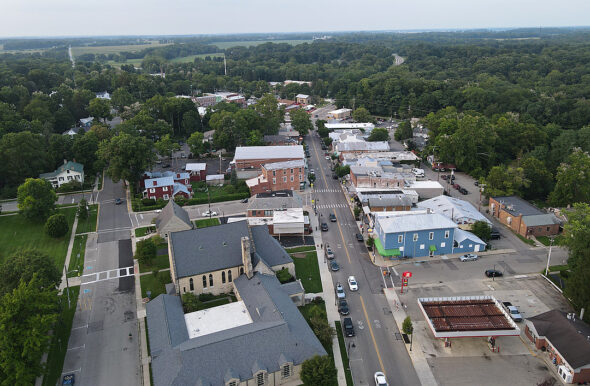
Aerial view of downtown Yellow Springs in early August. (Drone photo by Bryan Cady)
Eye on the Economy | Yellow Springs business owners respond to inflation, tariffs
- Published: April 2, 2025
EYE ON THE ECONOMY | This is the first in a revival of a recurring YS News series that examines the economic landscape in Yellow Springs. Click here to read past “Eyes on the Economy” articles.
As the temperatures have slowly started to rise, so too has foot traffic in downtown Yellow Springs: Tourist season is almost here.
Many Yellow Springs business owners are looking forward to the warmer weather ahead, when they hope to recoup their losses from what several reported was the slowest and most economically challenging winter in recent years.
In speaking with business owners, the News learned that the annual winter slump is only the tip of the iceberg — that nationwide macroeconomic forces such as inflation, lingering COVID-era supply chain issues and competition with nearby big-box stores all continue to compound the plight of running a small business in Yellow Springs.
Then, there are the tariffs. While President Donald Trump has so far implemented a 25% tariff on steel and aluminum on China, on top of pre-existing ones, Trump has threatened an additional global trade shake-up on April 2 — what he has dubbed “Liberation Day” — when he is expected to impose massive trade duties on any nations that have imposed duties on U.S. exports, such as Mexico and Canada.
As a number of Yellow Springs business owners told the News, the effects of these far-reaching tariffs will likely trickle down to the goods and products that line their shelves and appear on our dining room tables.
Worse yet, some economists are forecasting a national recession by the end of the year.
So how are our small-town shops, stores and services weathering this economic moment? To what extent have rising costs fallen on the consumer — villager and visitor alike? And what, ultimately, can be done to mitigate the worst effects?
What they’re up against
“Just like in any business, prices fluctuate — sometimes they go up, sometimes they go down,” Jeff Gray, owner of Tom’s Market, told the News this week. “Right now, the trend is yes, they’re going up. Anyone who’s shopped here can see that.”
Gray, like many small-town grocery store owners across the country, has seen firsthand the effects of rising costs of the products he stocks.
Nearly every category in the food pyramid costs a little more to stock these days, he said. Rising prices of meat and cheese have stunted the once robust deli counter, and the limited availability of products — produce, household items and more — from the store’s suppliers has reduced the number of brands available to his customers.
Most emblematic of the rising costs at Tom’s Market are the eggs in aisle four. The widespread H5N1 avian flu — which last year alone killed more than 40 million egg-laying birds, and which spurred the multiyear mass euthanization of 148 million birds in the U.S. — dramatically affected the availability and price of eggs at Tom’s Market and elsewhere.
Whereas cartons of eggs at Tom’s were previously priced at a relatively consistent average of $4 over the past few years, Gray said prices hovered between $8 and $9 in recent months — though, with a sigh of relief, he added that egg prices appear to be stabilizing closer to $6 a carton.
“So, yes, these prices do get passed on to the consumer, but as a single-owner grocery store, my buying power is low compared to these other places — Walmart, Meijer, Kroger — who can offset the effects of inflation and tariffs more easily,” Gray said. “I need to keep the bills paid, the lights on, the refrigeration equipment running, and I don’t have a multi-billion bankroll to help me through the storm.”
What could help him weather the storm, Gray said, may be a mindset shift among village residents who, in Gray’s view, can likely afford his competitive prices and who ought to eschew the conveniences of stopping by large corporate grocery stores on their way home from work — that is, if they want Tom’s Market to remain where it is.
“I get it, I really do. It’s easy to make a trip to Kroger when you’re headed back to town,” Gray said. “And now, you can sit at home, get on your phone, and have someone bring groceries to your front door. Honestly, there’s no way I can compete with that.”
Still, Gray has no intentions of closing his doors any time soon; he’s exploring new food vendors, suppliers and purveyors to keep prices as low and products as varied as he can.
Two blocks away and still in the heart of the downtown business district is the Yellow Springs Baking Company, which, as co-owner Rob Houk said last week, is doing its best to keep prices low despite the growing costs of doing business.
“Our egg prices have almost doubled recently,” Houk said, echoing Gray. “We almost raised our prices for customers, but we’re here to provide value for our customers. I don’t want any pushback, and I have faith that the prices will come back down.”
In addition to soaring egg prices — which, for a bakery, is not an insignificant ingredient — Houk and his partner Karina Tafolla have had to suffer the skyrocketing costs of paper packaging for their baked goods, which, according to Houk, have risen 33% in recent months.
Christine Monroe-Beard, owner of Ye Olde Trail Tavern, also cited mounting costs of containers and disposables.
“So, cutlery, straws, napkins, to-go containers, anything paper,” Monroe-Beard said. “We used to do all eco-products, but the prices are just astronomical anymore. It breaks my heart to use styrofoam, but it’s not logical to use all paper products anymore.”
Like the other local business owners, Monroe-Beard said she tries to be mindful of how and when to raise the prices on her German-oriented food menu. According to her, hiking prices too abruptly or without any consideration for what her customers can afford would likely hurt the Tavern’s customer base.
Her solution, at least for now: “Watching every single penny a lot closer.”
“We have a razor-thin margin,” Monroe-Beard said. “To save money, I’ve started doing a lot of my own maintenance and repair work that I would normally hire a local handy person to do. It’s things like that that allow us to keep our menu prices where they are, but really, it’s a fine line.”
It’s a similar story in the Millworks Business Center just down the road, where two markedly different businesses are keeping their eyes on Trump’s tariffs on imported aluminum.
For Yellow Springs Brewery, it’s their cans of beer; for Village Solar Co., it’s many of the constituent parts of their residential and commercial solar panels.
“We’re a little anxious about what comes next,” YS Brewery chief operating officer Jayson Hartings said. “If the price of aluminum goes up for our vendors, then it goes up for us.”
Hartings noted that this predicament is worsened by an over-saturated alcohol market in which craft beer no longer has the same appeal and cachet it did about a decade ago.
“It’d be tough for us to raise prices for our consumers when we’re already in a struggling market,” he said. “There aren’t any plans to pass costs on to the consumer, but we still have to see how these tariffs and a possible recession affect our bottom line.”
Likewise, Hartings added, the brewery’s hops and malts come from various European countries. Who knows, he mused, how mounting import costs could affect that facet of their production line.
Village Solar, also headquartered at Millworks, isn’t experiencing any effects from Trump’s tariffs “so far,” owner Alex Roland said, but that could change.
“We’re still purchasing existing inventory from our distributors and manufacturers,” Roland told the News. “I imagine we’re going to get hit with the impacts in a few months once existing inventory is exhausted and new equipment hot off the presses becomes the only option available. I try to use U.S.-manufactured equipment, but a lot of the raw material isn’t U.S.-sourced.”
According to Roland, the solar industry as a whole will likely experience the same thing. On most solar panels, a sizable portion of the hardware is steel; ground mounts are mostly steel; iron-ridge rails for roofs are aluminum; panel frames are aluminum; and electrical service wiring is by and large aluminum.
“It’s tricky to reach the domestic content requirements as the U.S. doesn’t produce many of the necessary components,” Roland said. “They are imported.”
Elsewhere in town is Dan Badger’s Yellow Springs Hardware, which, as many local residents have observed in recent years, and as the News has previously reported, is quite unlike most other conventional hardware stores.
“When my wife and I started talking about taking over the hardware store [in 2021], we knew the traditional model wasn’t working well enough to be sustainable,” Badger said. “We entered this business knowing that we were going to have to turn it into something else to make it viable.”
And they did. The hardware store is now — by Badger’s math — 70% hardware bits and bobs, and 30% a performance space, music venue, repair shop, classroom, community gathering hub and more.
“It’s that stuff that makes the business sufficiently profitable to cover the losses of the store,” Badger said. “In selling just hardware, we operate at a significant loss. All the other things we do are necessary to subsidize the retail side of things.”
With the big-box home improvement chain Menards just down the road, the inordinately inflated costs of plumbing, PVC and brass materials, as well as distributors’ volatility in providing the hardware store’s best-sellers — air filters and bird seed — the hardware store’s supplemental features have been imperative.
“Without any one of them, we would not be open,” Badger said.
So, what can be done?
Each of the business owners with whom the News spoke had their own distinct, yet related suggestions on how local residents can support the small-town economy of Yellow Springs.
There was some consensus between Badger and Tom’s Market’s owner Gray about the imperative of shopping local when and where villagers can — though, Badger acknowledged that becoming a growing “luxury,” with money getting tighter and tighter for everyone.
The Tavern’s Monroe-Beard called for greater collaboration and communication among downtown business owners — especially owners of other bars and restaurants who could potentially benefit from joint mass-orders of materials and resources, and who host special events.
“So let’s not have karaoke in three different places all at once,” she said. “Instead, what if we had an occasional pub crawl, a villagewide restaurant week? We need more collaboration — a unified marketing scheme for Yellow Springs appealing to nearby areas that says, ‘Hey! We’re here!’”
According to the Chamber of Commerce Executive Director Phillip O’Rouke, he’s listening.
“The number one thing the Chamber is doing is fostering opportunities to listen to feedback from our members and the community as a whole — understanding what resources are available to help and that can target some of these struggles,” O’Rourke said.
As O’Rourke detailed, the Yellow Springs Chamber of Commerce — which presently has 212 member businesses, including some in neighboring Clifton and Springfield — offers its members a number of cost-saving resources: healthcare benefits, discounted payroll services, shipping and handling through FedEx and other networking-related boons through the Southern Ohio Chamber Alliance.
The YS Chamber of Commerce also offers a number of seminars for local businesses — the next on Tuesday, April 8, dubbed “Underwhelm Yourself with Google Workspace,” wherein local resident April Wolford will train attendees on marketing strategies, general shifts in the social media landscape and workflow optimization for businesses.
“But what are your immediate needs?” O’Rourke rhetorically asked local businesses. “Once we can identify what you need — not just in the short-term, not just an immediate infusion of dollars to help you get through the winter — then we can come up with a customized plan.”
He continued: “Beyond bringing people to Yellow Springs — around 50,000 for Street Fair annually — the Chamber’s job, my job is not to run your business for you, but to provide the tools and educational resources to benefit your business, which benefits all of Yellow Springs.”
Like the Chamber of Commerce, Village government is also beginning to make moves to improve local economic development initiatives.
Earlier this year, Meg Leatherman — formerly titled the Village’s planning and zoning administrator — assumed the role of planning and economic development director and was recently joined by the Village’s newest hire, Aaron Arellano, in the new planning and economic development coordinator position.
“These being somewhat new positions,” Leatherman told the News, “we’re primarily focused on right now just trying to get the word out that we’re here for economic development and building relationships with our local businesses.”
Arellano added: “So we’re about to start going around and getting feedback from Yellow Springs businesses — what do they need and how can the Village help? A lot of people, when they hear about economic development, think about bringing in new businesses. But really, our focal point is business retention.”
So, how will the Village help retain existing businesses?
According to Leatherman and Arellano, while the Village is still in the nascent planning stages of these programs, the Village may soon roll out subsidizing efforts to help Yellow Springs businesses curb utility costs in the winter, and work with businesses in applying for grants and revolving loans.
“But first, we need to hear from businesses before we launch anything,” Leatherman said.
As Leatherman acknowledged, though, the extent to which the Village can help the downtown business district is dependent upon the same macroeconomic forces that all the businesses face.
“The Village is also a business in a way,” she said. “Tariffs would mean we’d also experience higher costs for putting in and maintaining utilities and infrastructure. But I’ve worked through two other recessions in my career — it just means scaling back, streamlining processes and making things more efficient.”
“And we know the cost of things will increase over time,” Arellano added. “That’s just basic economics. In the meantime, it’s important for local businesses that the Village wants to do everything in our power to help them. Come talk to us. Let’s build a relationship.”
One Response to “Eye on the Economy | Yellow Springs business owners respond to inflation, tariffs”
The Yellow Springs News encourages respectful discussion of this article.
You must login to post a comment.
Don't have a login? Register for a free YSNews.com account.













The YS News discovers ‘inflation’. 3 years after it peaked at over 9%. Maybe I missed the ‘inflation’ hand wringing article back then. I’ll check the archives.